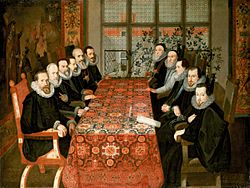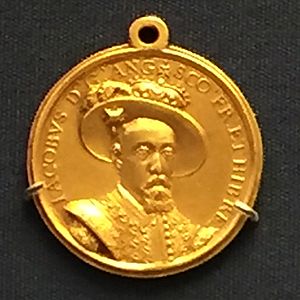Treaty of London (1604) facts for kids

The Somerset House Conference, 19 August 1604, unknown artist
|
|
| Signed | August 28, 1604 |
|---|---|
| Location | London, England |
| Languages | English, Spanish, Latin |
The Treaty of London (Spanish: Tratado de Londres) was an important agreement signed on August 28, 1604. This treaty officially ended the long and costly Anglo-Spanish War, which had lasted for nineteen years. It brought things back to how they were before the war started for both England and Spain. The discussions for this treaty likely happened at Somerset House in Westminster, London, which is why it's sometimes called the Somerset House Conference.
Contents
Why the War Ended: A Look at the Background
The Anglo-Spanish War was a complicated fight that involved other conflicts too, like the Dutch Revolt (when the Netherlands fought for independence from Spain) and the Nine Years' War in Ireland. By 1600, the war had been going on for about fifteen years, and neither side was winning clearly. Spain was getting tired and running out of money. Their soldiers in the Netherlands were even rebelling because they weren't getting paid. England also faced challenges. Both countries realized that they couldn't easily defeat the other.
Early Attempts at Peace
In April 1600, Archduke Albert, who governed the Spanish Netherlands, secretly tried to make peace with England. He didn't even tell Spain's king about it at first! The next month, representatives from Spain, England, and Burgundy met in Boulogne, France.
Spain wanted England to give up some important towns. England wanted to trade freely with Spain and its empire. They also wanted English people to be safe from the inquisition (a religious court) and to be the only ones with warships in the English Channel. These talks didn't go anywhere because both sides didn't trust each other. Also, the Dutch, who were fighting Spain, put pressure on England not to make a deal.
Even though those talks failed, England, Archduke Albert, and his wife, Isabella Clara Eugenia, kept trying to find a way to peace. Letters showed that Albert and Isabella really wanted peace, even if Spain's King Philip III had different ideas. Philip wanted Spain to remain the most powerful empire, while Albert and Isabella just wanted friendly relations.
When Queen Elizabeth I of England died in 1603, her successor, James I, quickly wanted to end the long war. By this time, Spain's hopes of winning big in the Netherlands or invading England were very low. King James was a peaceful person and wanted unity. He was also the son of Mary, Queen of Scots, whose execution had been a big reason for the war starting. Philip III of Spain had also inherited the war from his father, Philip II, and his country's money was running out. So, he was happy to hear about the peace offer.
Spain's main goal was to stop England from helping the Dutch rebels. Meanwhile, Johan van Oldenbarnevelt, a Dutch leader, tried to get the new English king to keep helping them in their fight against Spain, especially during the long and bloody Siege of Ostend.
The first real steps toward peace happened in June 1603. Juan de Tassis led a group from Spain and Flanders to London. They wanted to discuss truces and build trust. Tassis was sent by Philip III to see if a peace deal was possible after Elizabeth's death.
Archduke Albert had already sent his own representative, Charles de Ligne, to London. Tassis joined him in September 1603. Even though Tassis didn't have full power to sign a treaty, he worked hard behind the scenes to prepare for a settlement.
The Treaty: Who Was Involved and What Was Agreed?
By the end of 1603, the Constable of Castile (a high-ranking Spanish official) arrived in Brussels. He had the power to finalize the treaty if an agreement could be reached. On May 19, 1604, the rest of the Spanish delegation arrived in London. England also chose its team to negotiate.
England's Negotiators
- Robert Cecil, 1st Earl of Salisbury (1563–1612), who was King James I's main minister.
- Charles Blount, 1st Earl of Devonshire (1563–1606), a soldier.
- Thomas Sackville, 1st Earl of Dorset (1536–1608), in charge of the country's money.
- Henry Howard, 1st Earl of Northampton (1540–1614), a powerful official in charge of coastal defenses.
- Charles Howard, 1st Earl of Nottingham (1536–1624), the head of the navy.
Spain's Negotiators
Spain had two groups of negotiators. One group represented the King of Spain, and the other represented Archduke Albert and Isabella, who ruled the Spanish Netherlands.
The Spanish King's group:
- Juan Fernández de Velasco, 5th Duke of Frías, the Constable of Castile.
- Juan de Tassis, 1st Count of Villamediana.
- Alessandro Robida, a Senator from Milan.
The Spanish Netherlands' group:
- Charles de Ligne, 2nd Prince of Arenberg.
- Jean Richardot, President of the Brussels Privy Council.
- Louis Verreyken, a high-ranking official from Brussels.
What the Treaty Said
The Treaty of London had several key points:
- Spain officially accepted that England would have a Protestant king or queen. It gave up its plans to bring the Church of Rome back to England.
- Spain agreed to stop its military actions in Ireland.
- England agreed to stop attacking Spanish ships crossing the Atlantic Ocean and to stop interfering with Spain's colonies.
- The English Channel was opened for Spanish ships to use.
- England agreed to stop helping the Dutch Revolt. This meant England would no longer send soldiers or money to the Dutch rebels.
- Ships from both countries, whether for trade or war, could use each other's main ports to repair, find shelter, or buy supplies. If a fleet had fewer than eight ships, it didn't even need to ask for permission. This was a big help for Spain, giving them many places in England to support their war against the Dutch.
The treaty basically brought things back to how they were before the war. Spain had to accept that it couldn't make England Catholic again and had to recognize England's Protestant rulers. In return, England stopped helping the Dutch rebellion and stopped attacking Spanish ships and colonies.
What Happened After the Treaty?
After England pulled out of the war, Spain hoped to defeat the Dutch quickly. They launched a big military campaign in 1606 led by Ambrogio Spinola. However, King James still allowed English volunteers to join the Dutch army. In 1605, about 8,000 English soldiers were fighting for the Dutch. Also, English privateers (like legal pirates) started working for the Dutch, attacking Spanish ships.
On the other hand, Spanish warships and privateers were allowed to use English ports. This helped them attack Dutch ships or send more soldiers to Flanders. By November 1607, Spain's wars with France, the Dutch, and England had cost so much that Spain went bankrupt. This led to the Twelve Years' Truce, which officially recognized the independence of the Dutch Republic.
In England, many people didn't like the treaty. They thought it was a "humiliating peace" and that King James I had abandoned their Dutch allies to please Spain. It made James I very unpopular. Noel Caron, the Dutch ambassador in London, wrote that "no announcement was ever received in London with more coolness, yes—with more sadness." Because of this, there were no public celebrations in England after the treaty was signed. The disagreement between King James I's foreign policy and what the public wanted grew even more years later. This happened during the "Spanish Match," when the Protestant Parliament disagreed with the King's plan for his son, Charles, to marry Maria Anna of Spain, the daughter of Philip III of Spain. However, the English negotiators felt the treaty was a diplomatic success, giving England "peace with honor." Gold and silver medals were even made to celebrate the peace.
In Spain, the peace agreement was well received. There were big public celebrations in the Spanish capital, Valladolid, from April to June 1605. These celebrations honored the treaty and the birth of Philip's son, Philip IV of Spain. The English ambassadorial group, which had 500 people and was led by Lord Admiral Charles Howard, was also there. King James I had sent Howard in return for Don Juan de Velasco coming to England to negotiate peace the year before. The English group was welcomed warmly on May 26. Howard was even received at the English college. The treaty was then officially approved at the Royal Palace of Valladolid the next month, with Howard present. However, some people in the Catholic Church, like Juan de Ribera, the bishop of Valencia, were worried about making peace with a "heretical power" (Protestant England). After the agreement was finished, Philip III appointed Don Pedro de Zuñiga as the first Spanish ambassador to live in England.
After the peace treaty, the Spanish hoped that England would eventually allow more freedom for Catholics. However, the Gunpowder Plot in 1605 (a plan by Catholic extremists to blow up Parliament) destroyed any chance of this. Protestants in England feared that peace with Spain would lead to an invasion by Jesuits and Catholic supporters. But this didn't happen, as the laws against Catholics were strictly enforced by Parliament.
After the treaty was signed, England and Spain remained at peace until 1625.
See also
 In Spanish: Tratado de Londres (1604) para niños
In Spanish: Tratado de Londres (1604) para niños
- List of treaties


